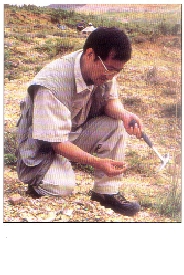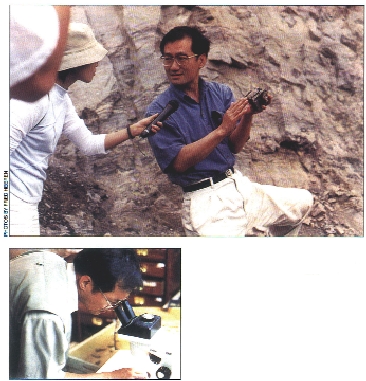
 | ||
Paleontologic Agitprop?
By Fred Heeren
Before smiling officials escorted an
international group of foreign scientists to fossil sites in
southern China last summer, they made sure gangs of
road-building political prisoners were trucked out of sight.
The fossil hunters who caught on to this unpleasant little
routine shrugged it off as a problem far from their concerns.
The scientists might have been concerned
about their own effort to hide troublesome matters —
matters that became more apparent when they settled into a
resort for a week-long symposium. Sixty scientists from around
the world gathered to deliver papers dealing with the
conference’s theme: “The Origins of Animal Body
Plans and the Fossil Record.”
Though the Western journals Nature and Science later
carried articles of the 530-million-year-old fossil discoveries
announced at this conference, they made no mention of the
central questions emphasized by the discoverers themselves: Why
do virtually all the forty or more major animal groups, called
phyla, first appear in the fossil record at the same time? Why
don’t we see new anima phyla continuing to evolve after
this? Why don’t Chinese paleontologists find many
millions of years of evolving ancestors for any of these
new-but-advanced-looking animals in the strata below them? And
why does the Chinese fossil record show evolution’s
subsequent history running opposite to traditional Western
evolutionary-tree diagrams?
In the West, the evolution of animal life
was a cumulative process, the eventual building up of major
changes by innumerable, small steps over hundreds of millions
of years. Westerners picture an ever-widening tree of life,
growing from a single trunk at the beginning and achieving
maximum diversity today at the top.
In China, however, the real work of
evolution looks more like a one-time event, the greatest
evolutionary changes occurring right at the start of the
Cambrian period. Chinese paleontologists interpret their fossil
cache as a record of a “macroevolutionary” event
that took place 543 to 535 million years ago. Within that
unique window of opportunity, something special happened,
something involving a coordinated influx of incredibly complex
genetic information — something that demands
“harmony”, as Chinese paleontologists put it,
rather than chance and competition.
Chinese evolutionary theory rarely is
discussed in English-language academic journals, even though
China is the place Western scientists must go to learn about
the origins of animal life on Earth. China contains the
only fossils in the world that are dated near the start of the
Cambrian period, when complex animal groups first exploded onto
the scene. International groups make regular pilgrimages
to Yunnan province and other paleontological hot spots.
Westerners have had several decades to get
used to the idea of “quick-time” evolution and
bushlike, instead of treelike, evolutionary diagrams —
mostly through the writings of Harvard paleontologist Stephen
Jay Gould. Perhaps the best-known paleontologist in the West,
he remains the most controversial, and his work receives short
shrift in undergraduate textbooks.
 | ||
Recognizing the lack of fossil evidence
for expected transitions between major animal groups, Gould and
his colleague Niles Eldredge (of the American Museum of Natural
History) promoted a concept they called “punctuated
equilibria. ” According to “punk eek,” the
fossil record of each animal is characterized by long periods
of “equilibrium” where nothing much happens, but
this tranquil state is occasionally “punctuated” by
relatively quick jumps involving massive changes in the animal.
Gould stresses the role of “contingency,” or chance
happenings, in provoking these major changes. Rerun the tape of
life, he says, and vertebrates, let alone humans, might never
appear.
In his 1989 book, Wonderful Life, Gould
praised Canada’s Burgess Shale fossils —another key
group of Cambrian fossils discovered in Canada —
for the “exquisite detail” of their
preservation, providing scientists with insight into a crucial
period. From his study of these fossils, Gould concluded that
no gradual steps possibly could connect pre-Cambrian fungus
with the Cambrian animals. He called
paleontologists’ efforts to make such connections
“fanciful at best.”
But the Chengjiang fossils, all Westerners
agree, are fare more exquisitely preserved — and 15
billion years closer to the beginning of the explosion of
animal body plans. Indeed, the chance to engage Chinese
paleontologist Jun-Yuan Chen is one of the prime motivations
for Westerners to travel east. Chen has co-authored half
of all papers on the Chengjiang animals, and he recently and he
recently discovered Homo sapiens’ earliest traceable ancestor, a small
fish-like animal called Haikouella. (While other paleontologists have claimed to
have found Cambrian chordates, Chen assembled more than 300
specimens of as Haikouella before announcing this discovery.) Haikouella had
a full complement of eyes, a rain, a heart, an esophagus,
intestines and so on — appearing so sophisticated that
some are classifying the animal as a vertebrate. As a
result of Chen’s work, paleontologists now include our
own chordate phylum with those that appeared in the early
Cambrian.
“Some of these specimens are
absolutely gorgeous,” says primitive chordate specialist
Nicholas Holland of San Diego’s Scripps Institution of
Oceanography, who worries about a problem this discovery raises:
“Where are Haikouella’s ancestors? The sixty-four dollar question
is, What is this hooked to? That nobody knows.”
Three years ago, the search for ancestors
to the Cambrian animals took Chen and Taiwanese biologist
Chia-Wei Li to a Precambrian mining site called Weng’an.
Knowing that the Precambrian rock there had preserved seaweed,
they dreamed of finding developing arthropods — or
fossils showing steps leading to any of the 40 or more diverse
Cambrian animal groups. At a minimum they hoped to find animals
with bilateral symmetry, the most basic characteristic of
Cambrian animals (and most animals today). A bilateral animal
is one with a top and a bottom, with left and right sides that
are nearly identical.
Soon after they began digging, Chen and Li
found sponges and tiny sponge embryos. The West publicized the
event on network television and the front pages of major
newspapers as a great stride in finding the long-sought
Precambrian animals. But Chen and Li were disappointed not to
have found any bilaterians; they hadn’t found a truly
viable ancestor for any of the new animals appearing in the
Cambrian explosion.
Moreover, by finding sponges and their
microscopically tiny embryos in the Precambrian, they
inadvertently rebutted Westerner wisdom. Charles Darwin himself
had said that in order for his theory to work, the ancestors of
the Cambrian animals must have been evolving for long ages
prior to their Cambrian appearance. The reason scientists still
haven’t found them, according to Westerners, is that the
ancestors must have been too small or too soft, or the
conditions for fossilization too poor. But Chen and
Li’s discovery had actually demonstrated that small and
soft animals were preserved in Chinese Precambrian strata.
“The 580-million-year-old
phosphorous rock has good potential to preserve animals, if
they exist,” Chen reported to the conferees. “I
think this is a major mystery in paleontology, because we
didn’t find hard evidence to show that this large number
of Cambrian phyla was existing earlier. For me, natural
selection is not enough to explain the number of evolution
novelties.” More recent evidence for a possible
bilaterian animal near the Cambrian/Pre-Cambrian boundary
doesn’t solve the problem. Li was also direct:
“Evolution should be built on gradual change: mutation
plus mutation creating the species, and then the genera and
then the family—so how can these animals appear
suddenly?”
Western scientists would have none of it.
“It doesn’t matter if you find it or not!”
declared German biologist Dieter Walossek, rallying his Western
colleagues around him. “It’s there! It’s by
law! All of the major taxa should have been there in the
Precambrian, whether proved or not!”
Valuing theory over data is giving Western
science a bad name in the East. During the same week that
Westerners read reports in Science and Nature that stressed the
Darwinian lessons to be learned from Chen’s discovery of
the earliest chordate, the Communist Party’s Guang Ming Daily gave
the Chinese people a different story. “Evolution is
facing an extremely harsh challenge,” wrote Chinese
reporters in an article, “Darwinism — Science or
Religion?” Using adjectives such as
“dogmatic” and “authoritative” to
describe America’s neo-Darwinism, the paper suggested
that the theory had taken a wrong turn somewhere in the West.
: “In the beginning, evolution was advanced as a
scientific hypothesis; one that should be under serious
scrutiny from all angles.” The article concluded that,
because of the need to contend with creationists, scientists
became hypersensitive to any dissent from their “immature
science,” and “evolution eventually changed into a
religion.”
Today, as a result of Chinese
paleontology, biologists must choose between classic Darwinism
and “saltation,” the idea of evolution in quick
jumps, says biologist Holland. Chinese gossil discoveries have
wrought havoc upon his once-tidy tree of life: “You just
hardly know what order to put the material in now. I mean, you
might as well just present the phyla alphabetically. It’s
come to that.”
In China, the Cambrian mystery has
recently inspired the building of large new
government-sponsored research centers devoted to its
investigation. At the heart of their research lies a
declaration anathema in the West: a proclamation of the mystery
of animal origins on Earth. Rather than “survival of the
fittest,” Chen believes scientists should focus on why
life kept evolving beyond the fittest. Microbacteria are the most
successful forms of life, Chen noted, since they make up most
of the Earth’s bio-mass and have survived while all other
forms have a way of going extinct. Complex life is less capable
of making adaptations. If all we have to depend upon is chance
and competition, the conventional forces of evolution, Chen
said, “then complex, highly evolved life, such as the
human, has no reason to appear.”
At the conference, Chinese scientists
encouraged the investigation of a variety of new hypotheses to
explain the Cambrian explosion: hydrothermal eruptions, sudden
seafloor changes, even intelligent design. This last was too
much for one American paleontologist, who stood up and shouted,
“This is not a scientific conference!”
Such a tactic, say critics, is the
West’s ultimate tool for keeping Chinese scientists at
bay: Define all dissent from neo-Darwinism as outside the realm
of science.
Ironically, Communist China is famed as a
repressive society; the West is supposed to promote the free
dissemination of information. Indeed, the American president of
the National Academy of Sciences, Bruce Alberts, recently
compared science to democracy, in that both accommodate, and
are strengthened by, dissent.
For now, however, data contrary to
classical neo-Darwinian ideas are as closely guarded as nuclear
secrets. Just how powerful is Chen’s “mystery of
life”? And why would anyone want to keep
neo-Darwinism’s shortcomings a secret? Westerners
attending paleontology conferences in the East prefer to steer
the discussion away form such questions.
* * *